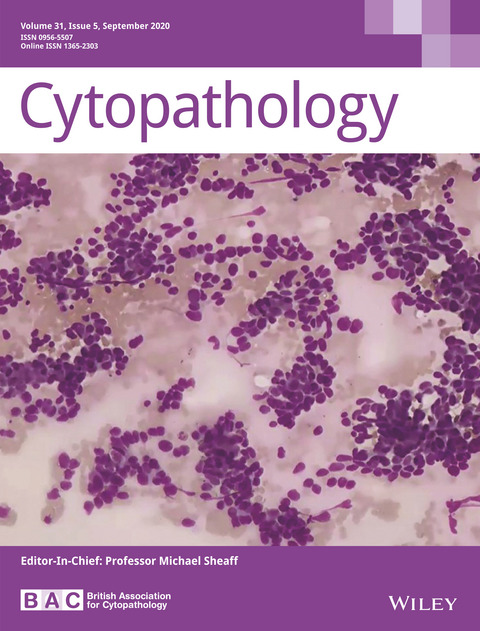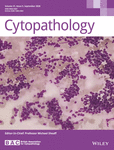Journal list menu
Export Citations
Download PDFs
COVER IMAGE
Cover Image
- Page: i
- First Published: 28 August 2020

Cover Illustration: The cover image is based on the Original Article Assessing competency for remote telecytology rapid on-site evaluation using pre-recorded dynamic video streaming by Sara E. Monaco et al., https://doi.org/10.1111/cyt.12794.
ISSUE INFORMATION
INSIDE THIS MONTH’S CYTOPATHOLOGY
EDITORIAL
REVIEW ARTICLES
Current state of whole slide imaging use in cytopathology: Pros and pitfalls
- Pages: 372-378
- First Published: 05 February 2020
This review summarizes the advantages and the disadvantages of the use of whole slide imaging (WSI) in cytopathology, starting from the cytological specimen to the entire laboratory and istitution. Whole Slide Imaging provides high-quality standardized slides, but there is still a need for validation studies before full adoption for primary diagnosis. Whole Slide Imaging in cytology retains most of the advantages of surgical pathology, and in the near future barriers to adoption will be overcome.
Review of different platforms to perform rapid onsite evaluation via telecytology
- Pages: 379-384
- First Published: 07 June 2020
There is increased utilization of cytopathology to provide rapid onsite evaluation of fine-needle aspiration and touch preparations of small biopsies. Different telecytology platforms for rapid onsite evaluation will be reviewed.
The cytopathologist's role in developing and evaluating artificial intelligence in cytopathology practice
- Pages: 385-392
- First Published: 19 January 2020
Artificial intelligence (AI) technologies have the potential to transform cytopathology practice and it is important for cytopathologists to embrace this and place themselves at the forefront of implementing these technologies in cytopathology. This review illustrates an archetypal AI workflow from project conception to implementation in a diagnostic setting and illustrates the cytopathologist's role and level of involvement at each stage of the process.
ORIGINAL ARTICLES
Quantitative image analysis for CD8 score in lung small biopsies and cytology cell-blocks
- Pages: 393-401
- First Published: 17 February 2020
This study looks at the feasibility of using image analysis to quantitate CD8-positive T-cells in a series of primary non-small cell carcinomas. The authors used matched small biopsies (core needle biopsies and/or cell bslocks) with matched resections to evaluate the concordance of the CD8 score in different specimens and using different annotation methods.
Telecytology rapid on-site evaluation: Diagnostic challenges, technical issues and lessons learned
- Pages: 402-410
- First Published: 26 January 2020
This article describes the experience of a unit which has utilised Telecytology for rapid on-site evaluation (ROSE) since 2017. Although considered successful, the diagnostic challenges and technical issues are shared to assist others who are considering or planning to utilize telecytology for ROSE.
Assessing competency for remote telecytology rapid on-site evaluation using pre-recorded dynamic video streaming
- Pages: 411-418
- First Published: 05 December 2019
This paper illustrates that an assessment tool for telecytology competency for ROSE using pre-recorded dynamic streaming videos is feasible. In addition, the novel test provided users with valuable feedback about their ROSE performance and provides feedback on the challenges related to telecytology ROSE.
The utility of cell blocks for international cytopathology teleconsultation by whole slide imaging
- Pages: 419-425
- First Published: 21 January 2020
The role of telecytology for consultation is emerging. This paper describes the authors experience with the use of cell blocks and whole slide imaging for international telecytology consultation and outlines key factors responsible for a successful telecytology consultation service at an academic institution.
Feasibility of a deep learning algorithm to distinguish large cell neuroendocrine from small cell lung carcinoma in cytology specimens
- Pages: 426-431
- First Published: 04 April 2020
Distinguishing small cell lung carcinoma from large cell neuroendocrine carcinoma is important for clinical management. However, making the distinction in cytology material can sometimes be challenging. Using open-source software, the authors designed a deep learning algorithm for classifying high-grade neuroendocrine carcinomas in fine-needle aspirations (FNA).
Impact of image analysis and artificial intelligence in thyroid pathology, with particular reference to cytological aspects
- Pages: 432-444
- First Published: 05 April 2020
Thyroid pathology has great potential for automated image analysis/artificial intelligence algorithm application on whole-slide images. Studies to date mainly deal with the assessment of immunohistochemical staining, quantification of cellular and nuclear parameters and discrimination between benign and malignant nodules. They show that correlation of automated assessment of immunohistochemical staining with manual pathologist's assessment is high and diagnostic performance of automated models is comparable with expert pathologist diagnosis
Artificial neural network model to distinguish pleomorphic adenoma from adenoid cystic carcinoma on fine needle aspiration cytology
- Pages: 445-450
- First Published: 06 November 2019
We have built an artificial neural network that can distinguish pleomorphic adenoma and adenoid cystic carcinoma on fine-needle aspiration cytology smears.
Role of fractal dimension in distinguishing benign from malignant endometrial clusters in liquid-based cervical samples
- Pages: 451-456
- First Published: 04 April 2020
This article describes the promising role of the fractal dimension in differentiating between benign and malignant hyperchromatic groups of cells in liquid-based cervical smear preparations.
Comparison of urine cytology diagnostic reports before and after the implementation of the Paris System classification system in China
- Pages: 457-462
- First Published: 04 April 2020
This study reports on the implementation of The Paris System (TPS) for urinary cytology in a centre in China. The authors conclude that TPS has contributed to the standardization of urine cytology reports and significantly improves the diagnostic sensitivity for high grade urothelial carcinoma.
False-negative ultrasound-guided fine-needle aspiration of axillary lymph nodes in breast cancer patients
- Pages: 463-467
- First Published: 22 June 2020
The purpose of this study was to clarify the clinicopathological features of patients with false-negative fine-needle aspiration cytology (FNAC). The false-negative rate of FNAC was high (31.5%). Micrometastatic disease was seen in patients with negative FNAC, and this might be the cause of false-negative FNAC results.
CASE REPORTS
Rhabdomyosarcoma of urinary bladder in a young man suspected and confirmed on urine cytology
- Pages: 468-470
- First Published: 20 March 2020
Mesenchymal tumors in the urinary bladder are very uncommon and their detection in urine cytology is rarer still. Mesenchymal tumors like rhabomyosarcoma must be suspected especially in young patients with appropriate morphology and confirmed with immunohistochemical markers.
Giant cell tumour-like features of myositis ossificans in cytology—a case report
- Pages: 471-474
- First Published: 28 January 2020
The diagnosis of myositis ossificans onfine needle aspiration cytology is a challenge due to variation in clinical, radiological and pathological findings in its three stages. A case is described with particular attention to the cytological features and diferential diagnosis.
CYTOPATHOLOGY CURIOSITIES
Septate hyphae (Rhizoctonia sp) in sputum cytology
- Pages: 475-476
- First Published: 07 May 2020
This article discusses the significance and characterisation of long branched yellowish filamentous structures found in a conventional sputum smear stained by the Papanicolaou method from a 55 year old gentleman who started immunosuppressive therapy six months previously when he had a kidney transplant.
ENIGMA PORTAL
Dedicated to teaching and education for all staff working in cytology laboratories worldwide
Persistent hydrocele fluid in a patient with transitional cell carcinoma
- Pages: 477-479
- First Published: 23 June 2020
This is a case of hydrocele fluid cytology, with very atypical cells, in a patient with a clinical history of urothelial carcinoma. The atypical cells were suspicious for malignancy and the differential diagnosis is discussed.
Massive mystery mass: cytological diagnosis of a neck swelling
- Pages: 480-482
- First Published: 28 February 2020
Chondrosarcoma is one of the most common malignant bone tumors. However, its presentation as a palpable mass in the neck is very rare, proving to be a clinical and cytological diagnostic dilemma. Identification of chondromyxoid stromal material, along with increased cellularity of the smears in conjunction with the radiological findings helps in clinching the diagnosis. Discussed here, is a case of well-differentiated chondrosarcoma, radiologically seen arising from and eroding the ribs, which could be diagnosed on FNAC done from a clinically palpable neck mass.
Imprint cytology for a subcutaneous tumour
- Pages: 483-486
- First Published: 14 March 2020
Imprint cytology of undifferentiated pleomorphic sarcoma (UPS) is reported. The cytologic findings are described in detail and a potential diagnostic advantage of cytology over histology is discussed with a brief review of literature.
Cytological diagnosis of cervical tuberculosis in a woman with cervical growth
- Pages: 487-489
- First Published: 20 March 2020
Tuberculosis of the female genital tract is often difficult to diagnose owing to the variable and non-specific clinical presentations in these patients. Cervical tuberculosis is rare and a proportion of these patients may present with cervical growth, which may clinically mimic cervical carcinoma. Cervical Papanicolaou smear examination is a non-invasive and inexpensive test that can be used to establish a diagnosis of cervical TB in these patients.
CORRESPONDENCE
Is micronucleus assay a suitable tumour marker in cervical carcinogenesis? Some concepts and paradigms
- Page: 490
- First Published: 24 June 2020
This letter discusses a previously published article in Cytopathology and provides comments the author believes allow better understanding regarding validating the micronucleus assay as a tumor marker in cervical carcinogenesis.
Fractal dimension and chromatin textural analysis to differentiate follicular carcinoma and adenoma on fine needle aspiration cytology
- Pages: 491-493
- First Published: 09 November 2019
A new form of technology is applied to cytology specimens in an attempt to solve the problem of distinguishing follicular adenoma from follicular carcinoma of the thyroid.




